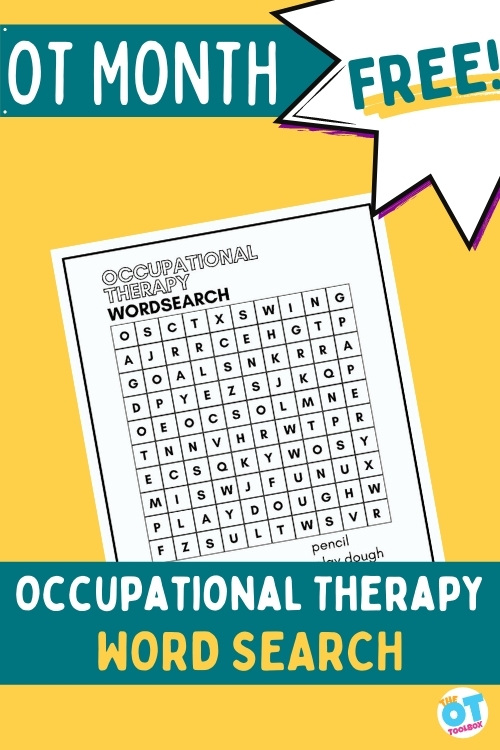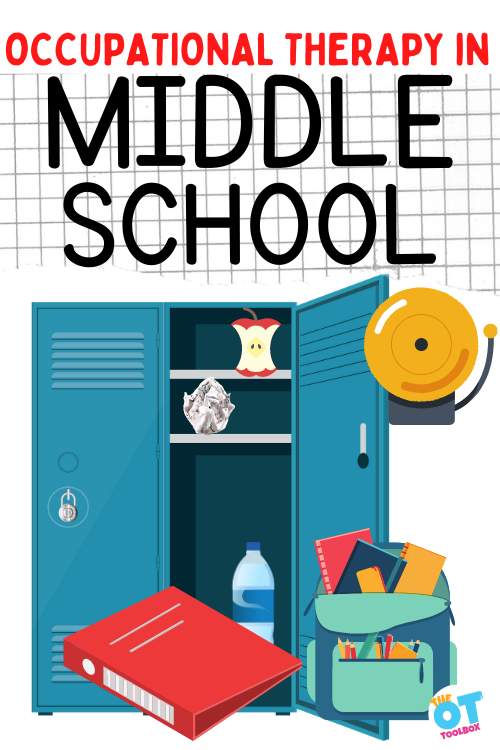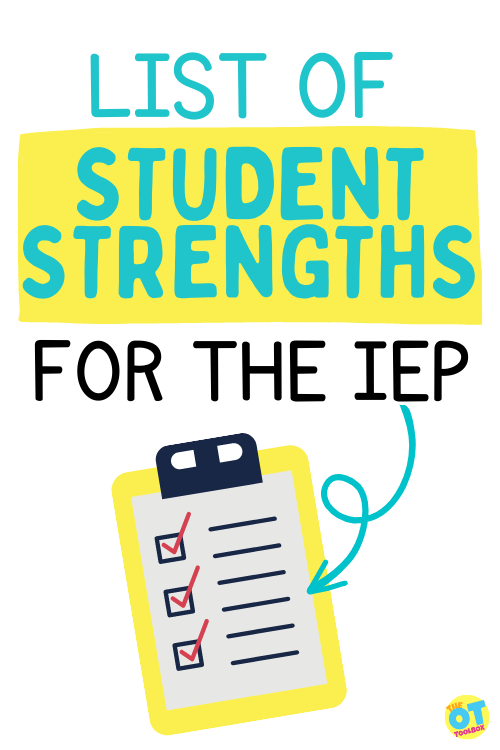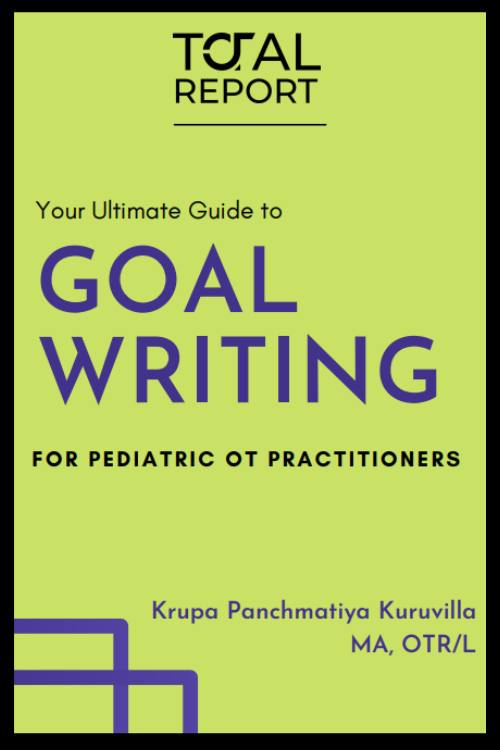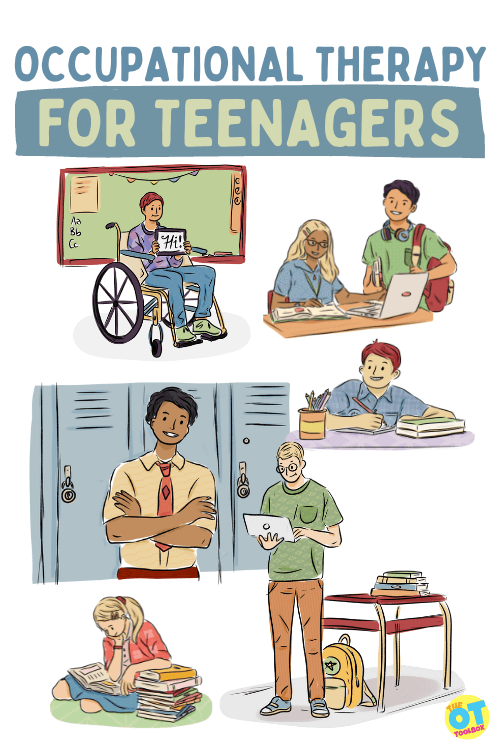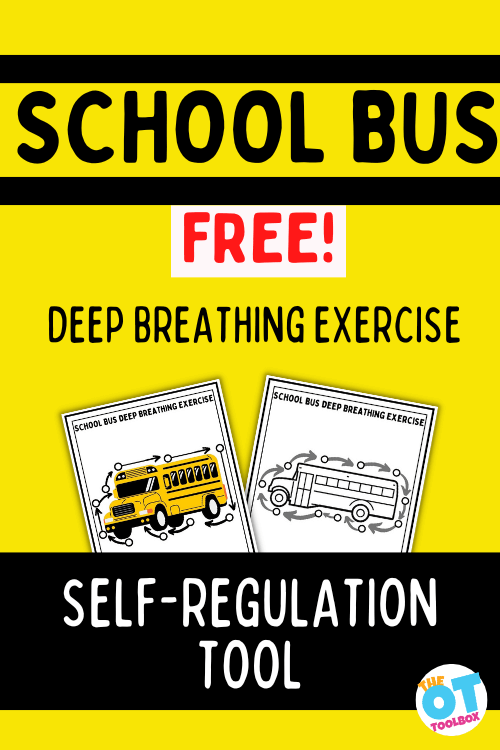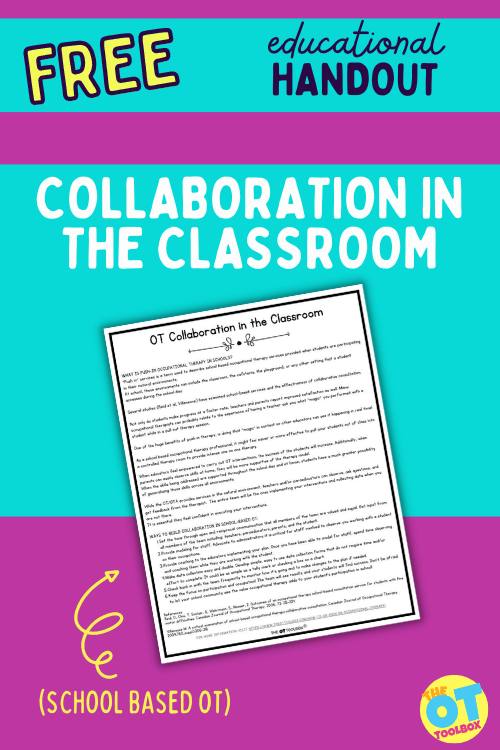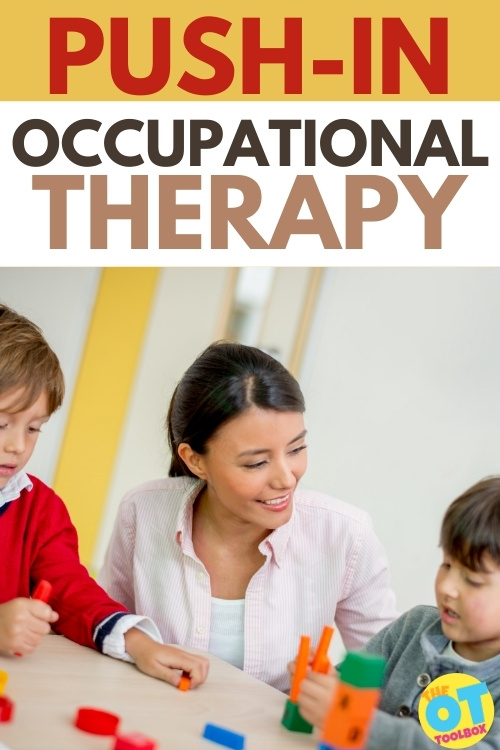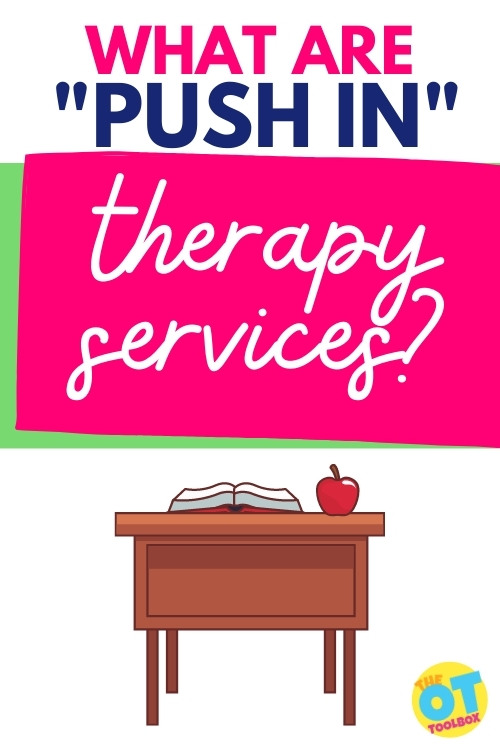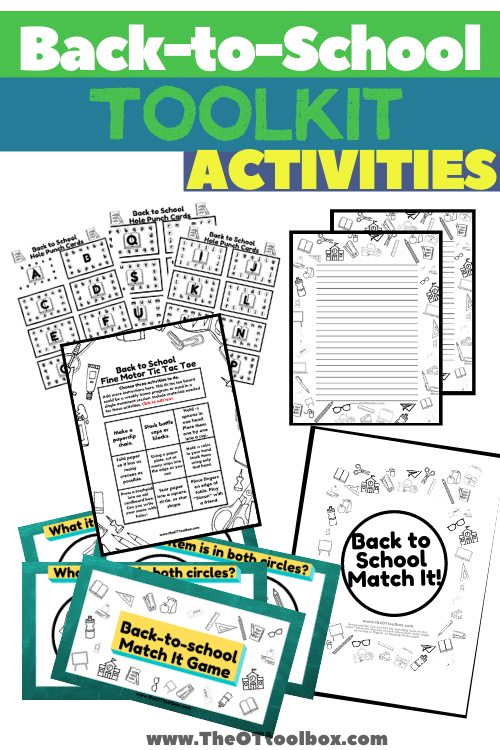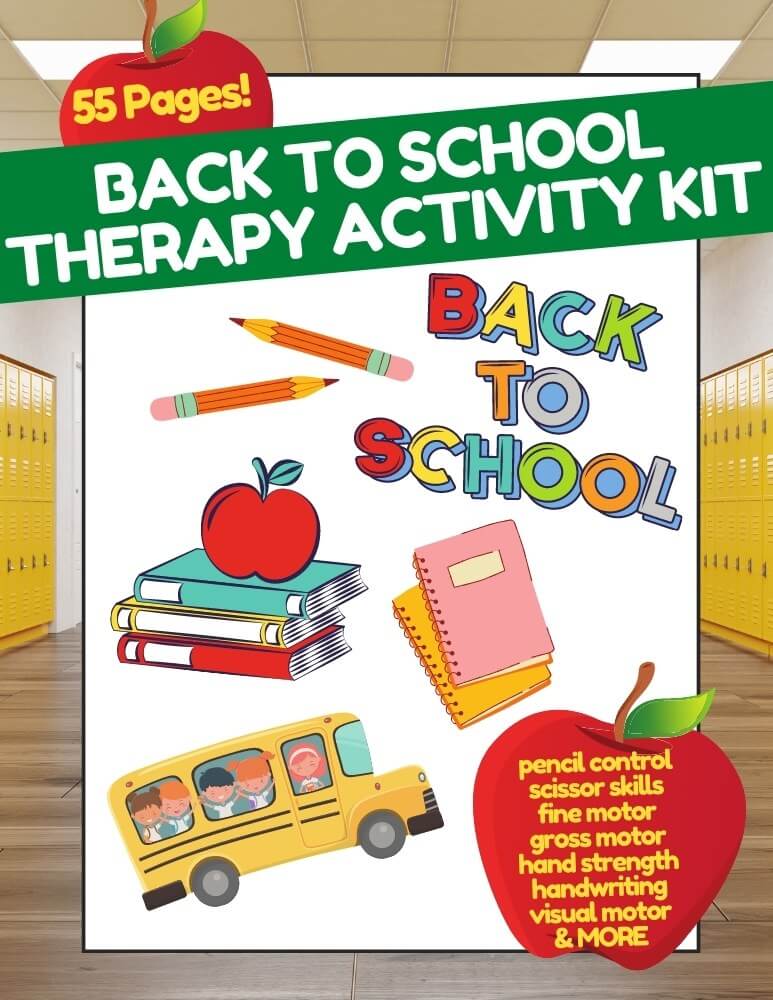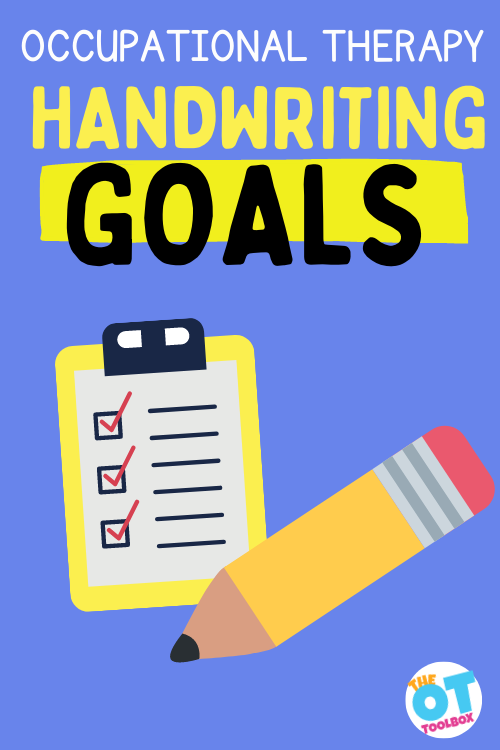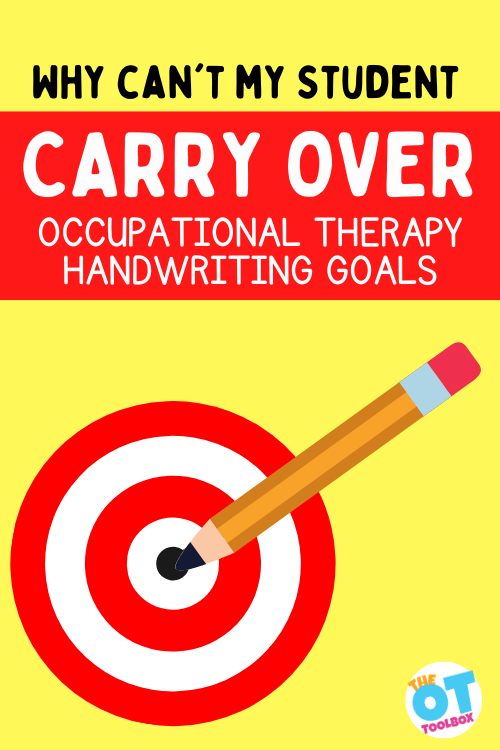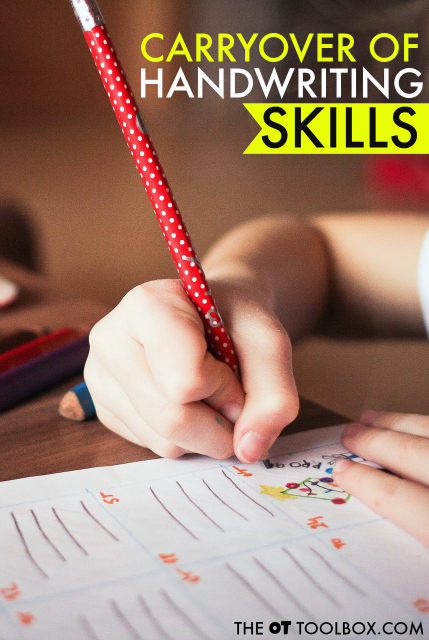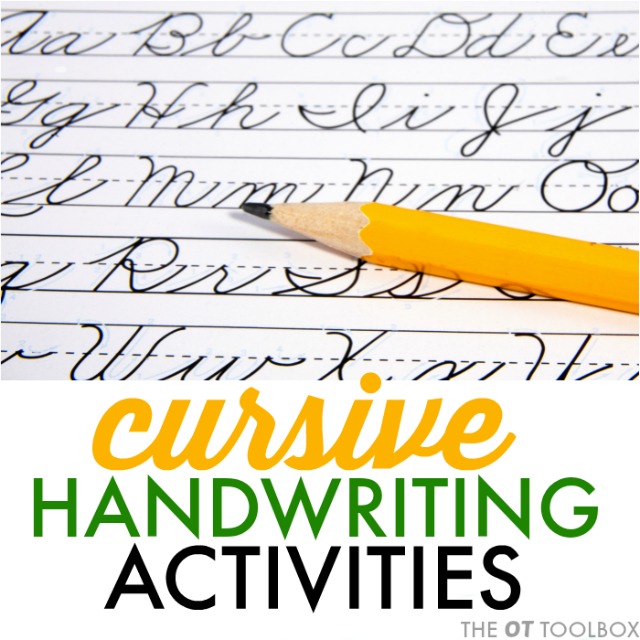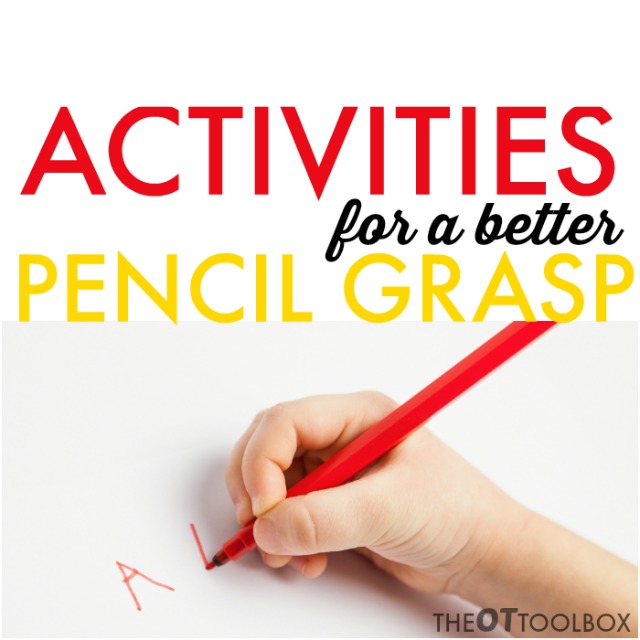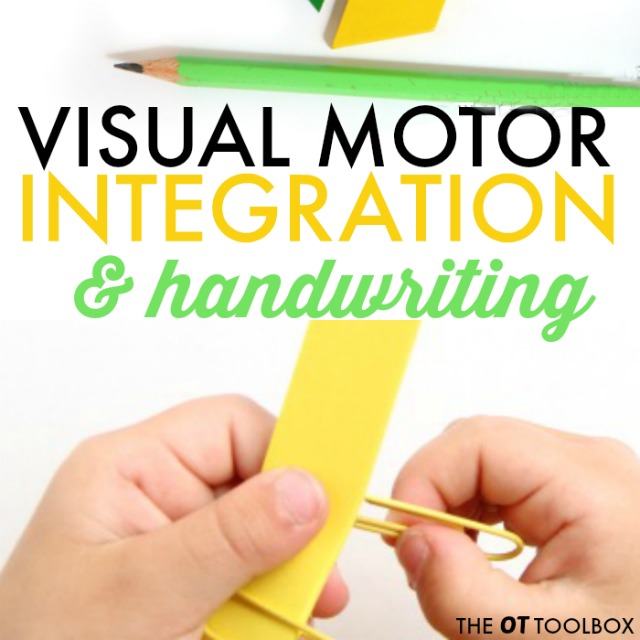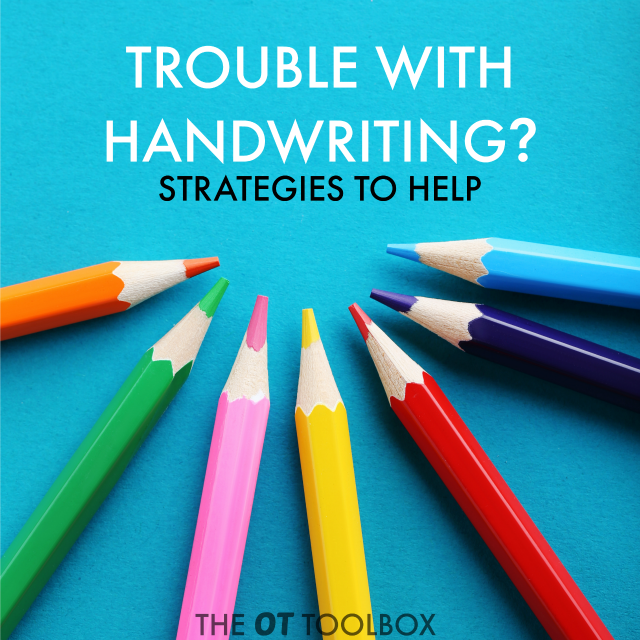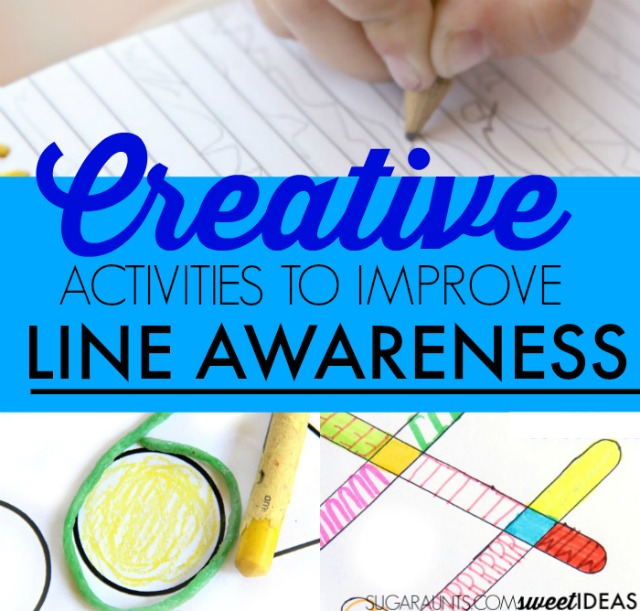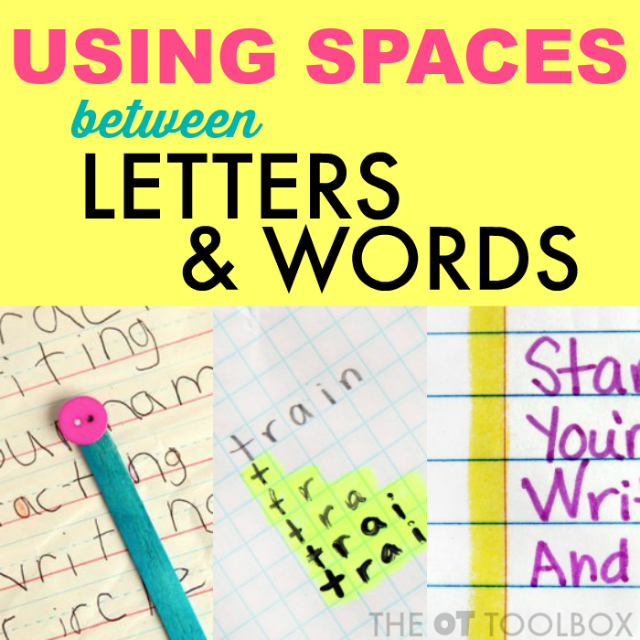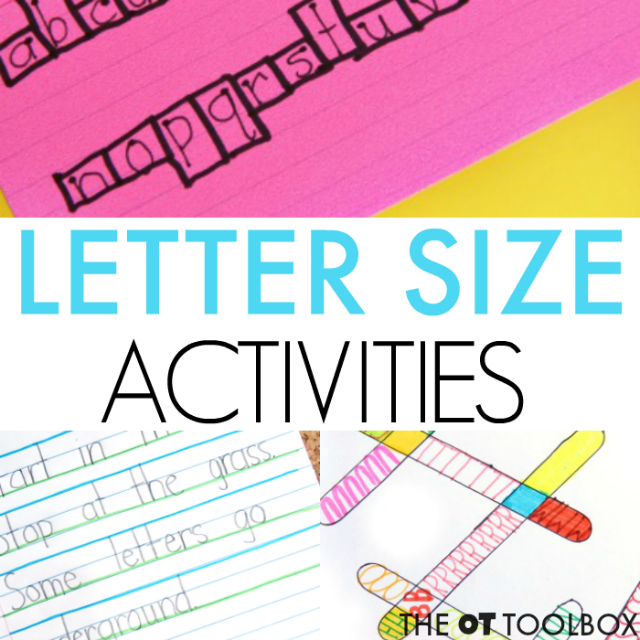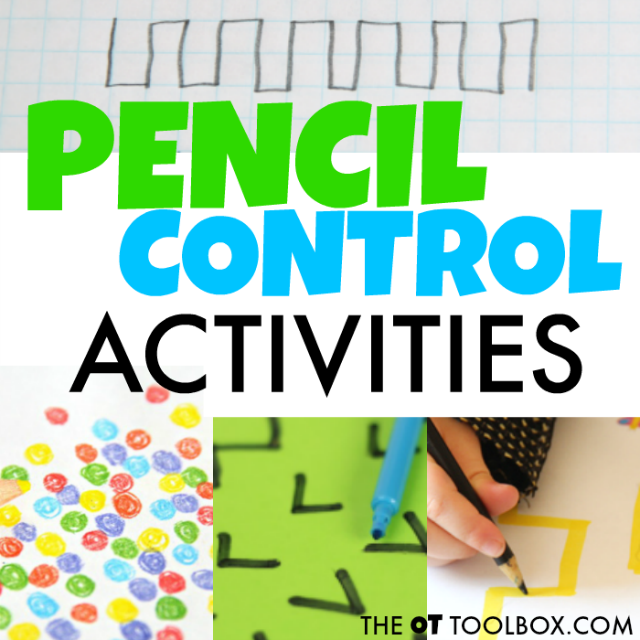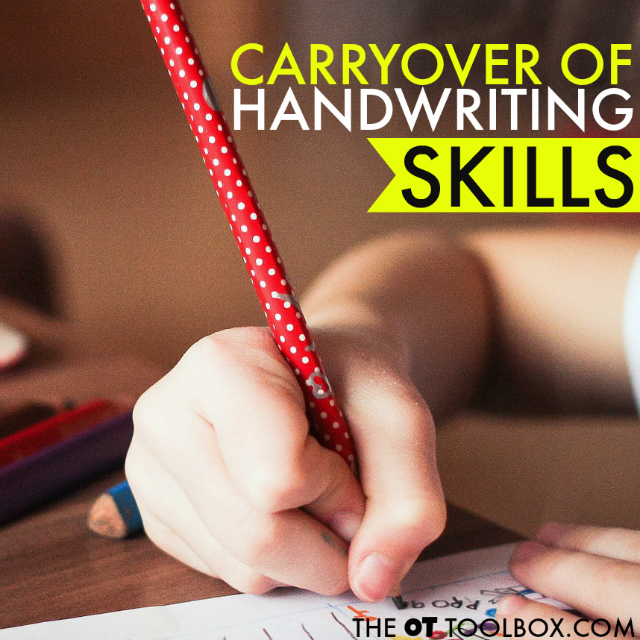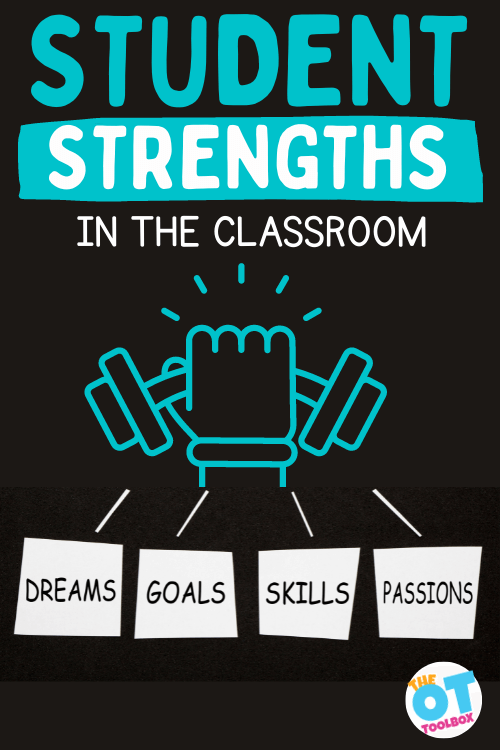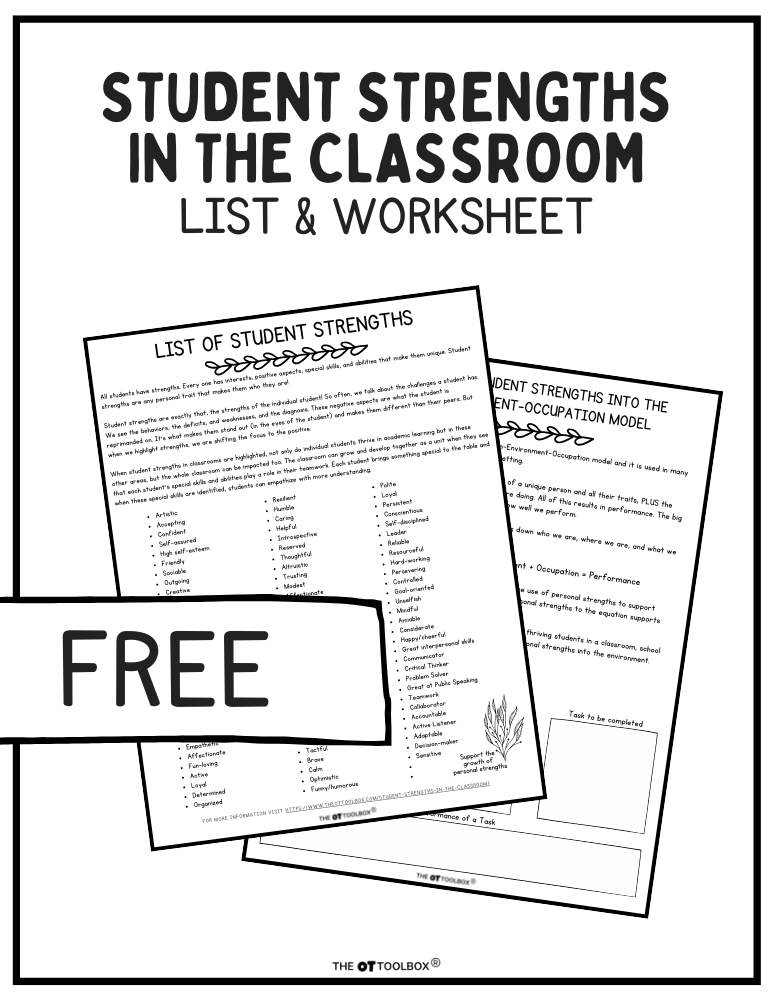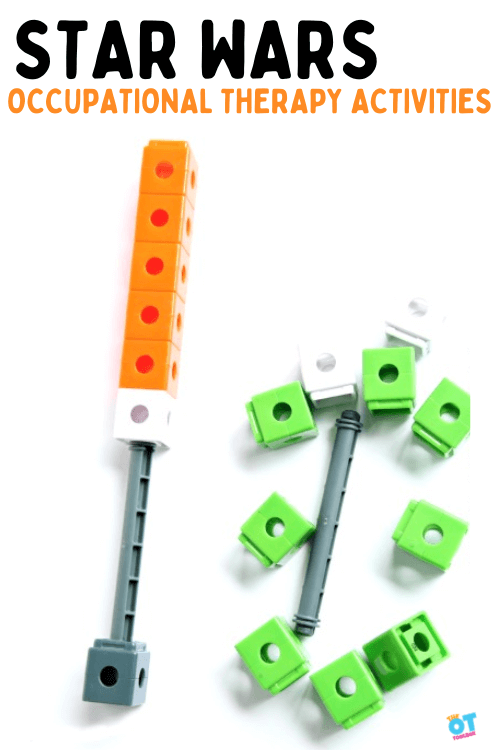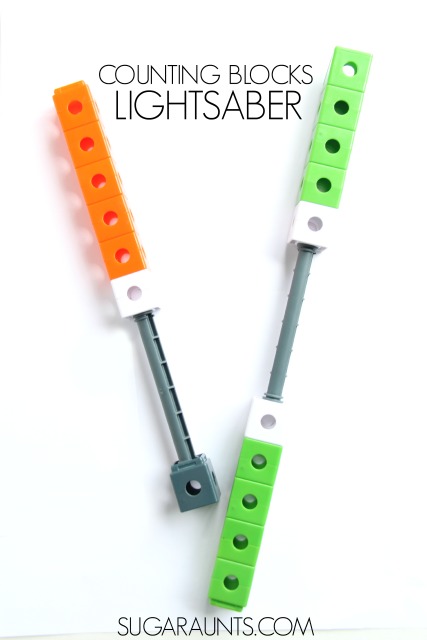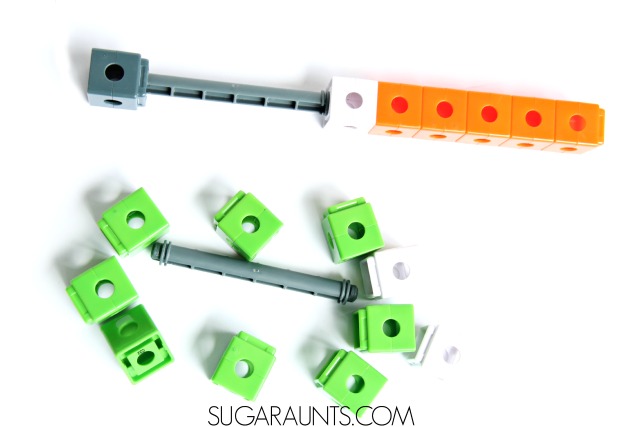This blog post on meeting handwriting goals is an old one on the website, but it’s a handwriting resource that needed a re-vamp to get the much-needed information out there. One thing that comes up a lot as a school based OT is this: Handwriting goals are addressed in OT sessions but you don’t see the carry over of those goals into real life handwriting situations. This is a real handwriting problem! Let’s break down handwriting goals to improve carry over and how to ensure success with handwriting IEP or 504 goals and accommodations!
What is Handwriting Goal Carryover
Handwriting carry over refers to the concept that the client working with an OT professional in therapy sessions can achieve skills in an isolated environment but are not able to carry over their new skills into the classroom, home, or community.
Carry over of handwriting goals is getting the skills to “stick” when the student goes back to the classroom or writes at home.
There is a lot to unpack here.
Handwriting carry over is specific to handwriting skills, and the reason we are covering this in its own blog post is that this is an area where therapy professionals most often see carry over issues. OT professionals work with students on one of the most common areas in the school environment: handwriting. We address handwriting so often because it impacts learning in such a huge way.
The other thing to consider is that handwriting skills are impacted and influenced by so many areas: sensorimotor, fine motor, gross motor, visual motor, executive functioning, etc.
Handwriting practice is a boring task for most kids. For the children who struggle with the underlying components of handwriting, practice is more than boring. It’s numbing. You can see it in the eyes of many kids who really hate handwriting practice. They glaze over. The child slouches down in their chair, and they go through the motions of writing practice.
And then what has been practiced is not carried over. We’ve covered so many handwriting problem areas on The OT Toolbox. You can find many resources under the handwriting tab at the top of the site.
What does therapy carry over look like?
To better understand this concept, let’s first cover what poor carry over over of handwriting skills looks like:
The occupational therapist or occupational therapy assistant works with a student in an isolated setting. They work with their students one on one, or in a small group. The therapy session may occur in either a pull out model of therapy delivery or therapy services occur using a push-in occupational therapy model of delivery.
In either situations, the student receives concentrated attention and focus on specific goal areas. Take a look at the handwriting goal examples listed below to better understand exactly how focused the therapy session can be.
While carry over of therapy goal areas occur in essentially every goal area we address, handwriting is one of the most commented on. We notice when the therapy professional helps a student working on copying the alphabet and they can form each letter accurately, but then when they complete a similar task in the classroom environment outside of the therapy session, the handwriting results differ drastically.
Another example of handwriting carry over is the student who can copy a list of words with accurate letter formation and line use. In the therapy session, the written work is very legible. But then, that same student immediately returns to the classroom and copies a list of vocabulary words only to show illegible written work with poor line use, poor spacing, and poor letter formation.
Why Handwriting Goals are difficult to carry over into the classroom
So a student does well in therapy sessions and the data shows the child IS ABLE to form letters accuratly, write on the lines, space between letters and words, and read their own writing. But what happens when those achievements don’t carry over to the classroom or the home?
There are several things to consider when it comes to transferring occupational therapy goals into real life. Some of these contributions may include:
- The handwriting goal is very specific (see goal examples below).
- The child is working on a targeted area of handwriting without distraction.
- The student has access to tools to support specific needs in the therapy session. This includes specialized adaptive paper, highlighted lines, positioning tools, etc.
- The student feels confident with their therapist by their side, that they can make a mistake and if a mistake occurs, it’s not a big deal. It’s part of therapy.
- The student has limited input of other contributing factors: classroom distractions, creative writing aspect, urgency to complete the writing task, etc.
- In the classroom environment, handwriting speed is a major contributor. The timeline of the classroom needs to move along, so the student may feel the urgency to keep up with others.
- Using specialized paper, pencil grips, handwriting positioners, etc. make the child feel “different” than their peers, so they revert to typical writing patterns rather than using tools that support written work.
All of this can be frustrating….to the child, to the therapy professional, to the teacher, and to the parent.
When the data shows the student has the capability to complete legible written work, and they have worked to strengthen underlying factors, and they have made progress on the goal areas, it is likely that the child can be discharged from therapy services.
Discharge from therapy can be a difficult thing for some parents and teachers to hear.
Therapy professionals have heard things like:
- Why can’t you adjust the goal so the child can write legibly in all settings?
- Why are you “giving up” on my child?
- Why are you discharging therapy when the child can’t read their own writing?
- And many other versions of this conversation!
What to do when the Handwriting IEP Goals are Not being carried over
The most important thing to remember is this: Occupational therapy is a support service in the schools. As such, OT professionals address goals that impact education. Therapy services occur at a level that, when handwriting is addressed (likely along with several other goals) for a time of 30 minutes per week.
The child will not progress when only practicing handwriting skills for such a short period of time. And this does not mean that increasing therapy time will make that pivotal difference. Whether a child receives OT services 30, 60, 90, etc., min a week, or 30, 60, 90 minutes a month of consultation, the story is the same: if the child doesn’t practice these handwriting skills every day, carry over is unlikely.
In order to see progression, and this is key, is that the child needs to practice skills throughout the day, at home, and each day.
The difference between successful and legible handwriting in all settings and poor carry over of skills is practice. How do we encourage this consistent use of skills?
- Practice daily
- OT homework that the child consistently completes at home
- Provide the teacher with suggestions to use for the classroom
- If a resource aide is available, work with that individual to encourage consistent use of supports: verbal cues, visual cues, specialized paper, pencil grips, etc.
- Work on “Small Wins”: When kids sit down to a writing assignment, they can get overwhelmed by the task ahead of them. Then, they know the individual challenges that they are faced with: forming letters correctly, writing on lines, copying sentences without skipping letters, making a “b” and not a “d”, forming letters the correct size, not mixing upper and lower case letters, holding the pencil the right way, not writing too dark or too light, erasing all of the mistakes…it’s a minefield of mistakes waiting to happen!
Work on small wins that can move a child toward a bigger goal. Ask the child to just focus on getting words on the paper. Another assignment can be only about writing on the lines. Another task can be just about making the letters the right size. Ask them to focus on just one thing. Then, when they are done writing, ask them what strategies they used to get that particular part of handwriting legibility done.
- Make a big deal about progress- Make small stars on handwriting that is legible, written on the lines, uses appropriate spacing, or meets other goals. Drawing attention to those small wins (even if there are other areas on the page where the handwriting lacked) can be a positive tool for kids who are working on handwriting.
- Teach someone else- When we teach, we learn. There is science backing the fact that when we teach something to someone else, it sticks better.
So use this strategy to get kids to notice the individual pieces of handwriting and teach them to another student (or the teacher!)
- Break the class down into groups of two.
- One student can write and the other is the teacher. They can “teach” how to write on the lines, how to erase mistakes completely, and how to make a straight left margin.
- Sometimes that simple assessment helps to make strategies stick better.
- Then, switch roles and the other students can become the handwriting teacher.
- Make Good Handwriting Part of a Routine: How do we remember to drink 8 glasses of water a day? For some of us, that is a real challenge. For others, they’ve got this covered. They have a routine of water guzzling ingrained in their day so much so that they can easily drink their required glasses of water. Have a cup of water on your desk at all times; make a schedule; make it part of your day!
- Make a visual schedule or checklist- So, how do kids make legible and proper handwriting just part of the process of writing? Use a personalized visual schedule for scheduling in handwriting practice time, or checklist to self-monitor handwriting.
- Make a DIY handwriting checklist- Some kids might have different items they need to monitor for legible written work. Maybe they need to make sure the tail letters drop down below the baseline. Write the particular handwriting concepts that each child needs to monitor on an index card and post it at their writing station. Laminate the index card and students can check off each item with a dry erase marker during writing tasks.
Kids can then look over their handwriting to make sure they’ve used proper formation, line awareness, spaces between words, and size of letters just right! Here is a printable handwriting self-checklist that you can print and use in the classroom.
- Technology and Typing- It these things are not working, it may be time to move onto technology as a means for written communication and/or modifications to requirements. Start a typing club for making this fun and engaging.
Handwriting Goal Examples
When it comes to occupational therapy and handwriting IEP goals, the goals are very specific. This is because they are individualized based on the specific needs of the child. The therapist is addressing handwriting in an isolated environment (which occurs whether servicing the child in either the pull-out model or the push-in model of therapy).
Poor transfer of occupational therapy goals can look like essentially any aspect of a handwriting goal.
Below are examples of handwriting goals. These are listed so you can see how specific each goal can be. The data collected from a handwriting goal will show how the student has progressed from a baseline status.
Focusing on these aspects of handwriting (copying from a model, tracing, writing upper case letters or lower case letters accurately, or focusing only on line use or spacing can help with carryover of handwriting goals into “real life”.
Goals for Pre-writing Lines
This goal is necessary for achieving the pre-writing skills required for forming letters and is typically a pre-kindergarten or kindergarten area of focus.
One strategy would be to support the learner in making marks on paper. The goals would focus on pre-writing strokes from a model such as vertical/horizontal/circular formations.
You can include grasping skills within the goal, or keep this separate.
Example: Student will demonstrate improved motor skills by copying vertical/horizontal/circular strokes from a model using a beginning tripod grasp 3 of 4 trials. You can further specify exactly what the strokes should look like in terms of length, degrees of the angles, and formation. The number of trials can be varied, as well as the grasping pattern.
For the student that is able to do pre-writing strokes of lines, a circle, and a cross, the pre-writing goals would focus on copying letters from a model.
There is debate on whether upper or lowercase should be emphasized first.
By the end of the IEP cycle, ________ will form/copy/independently draw (select appropriate terminology) pre-writing lines: vertical lines, horizontal lines, circle, cross, square ________ times in 4 out of 5 treatment sessions with ________ assist with no more than ____ visual/verbal cues (circle or include one or both) to complete the task for increased visual motor/perceptual, graphomotor skills.
Goals for letter formation
For students who are working on forming letters, we can target specific needs with the IEP writing goals.
Lowercase is used more readily, therefore people argue this should be addressed first. However, in terms of fine motor development, the sticks and large curves of uppercase letters are easier to master.
For practical reasons, many people write goals to write a student’s first name. This is a relevant goal, but not always a great starting point if your student has a long complicated name.
A general goal would be that student will copy 5/26 uppercase letters from a model. This does not limit which letters you choose, leading to more of a chance of success.
If you are using the Handwriting Without Tears model, letters are grouped by type, not alphabetical order.
Goals would follow the same format as above: student will improve…..by…copying 5/26 uppercase letters from a model. Variables: number of letters, letter formation, grasping pattern, sizing, spacing, line placement.
Generally goals involving copying basic letters from a model are intended to learn the basic formation, not exact details such as line placement. As the student improves, goals can expand to more letters.
For the student that can write several letters from a model – expand this goal to include all of the letters from a model (or 80-90% to allow room for error) The variables can be accuracy, grasping pattern, and formation.
For the student that can write all of the letters from a model – the next rung on the goal ladder would be to write them from memory. As with learning the letters, the goal can be a certain number/26 from memory. Add specifics such as uppercase, lowercase, accuracy, formation, grasping, etc.
For the student that can can independently form all letters from memory – at this point, the goals can focus on improving letter formation, sizing, and line placement.
Student will improve…by…accurately writing letters without a model with 80% accurate line placement, sizing, letter formation, and spacing.
For the student that can write all of the letters fairly legibly – the goals will focus on putting the pieces together. You can work on copying words from a model, writing from dictation, or writing from a prompt. Each of these types of writing varies in level of difficulty.
Student will improve…by writing a five word sentence from dictation with 80% accurate letter formation, line placement, sizing, and spacing using a tripod grasp. Here is a sample Handwriting Rubric to follow.
Focus is on letter lines. Letter formation is a huge aspect of overall handwriting legibility. All letters can be collected into groups, or families, based on the lines that make up that letter. These letters include:
- Straight line letters
- Curved line letters
- Diagonal line letters
These letter groups can also be further broken down by size:
- Uppercase letters
- Lowercase letters
Additionally, lowercase letters can be broken down into groups based on size:
- Tall letters (letters that touch the top line: b, d, f, h, k, l, t)
- Small letters (letters that do not go above the midline: a, c, e, i, m, n, o, r, s, u, v, w, x, z)
- Tail letters (letters with a “tail” that drops below the baseline: g, j, p, q, y)
Use our tall and short worksheet to support these concepts in a concrete yet expandable activity.
Finally, a group can be formed into cursive or print and then the cursive group can be sorted into uppercase/lowercase, size, and lines included in the letter:
- Cursive letters
- Print letters
As you can see, there are a lot of ways to sort out letter formation goals and address each these areas. Goals can be really focused on when in isolation in therapy sessions, but when you put the whole picture together, there can be a struggle to carry over those goal successes into classroom or other real life handwriting tasks.
Some examples of handwriting goals for letter formation include:
By the end of the IEP cycle,_____________ will form/copy/independently write (select appropriate terminology) straight line/curved line/diagonal line (include letter line aspects or generalize to all upper case) capital letters/lower case letters (select appropriate format) ________ times in 4 out of 5 treatment sessions with ________ assist with no more than ____ visual/verbal cues (circle or include one or both) to complete the task for increased graphomotor skills while maintaining a tripod grasp.
By the end of the IEP cycle, _____________ will form/copy/independently write (select appropriate terminology) lower case letters/upper case letters (select appropriate format) with good formation ________ times in 4 out of 5 treatment sessions with ________ assist with no more than ____ visual/verbal cues (circle or include one or both) to complete the task for increased graphomotor skills while maintaining a lack of thumb wrap.
By the end of the IEP cycle, _____________ will form/copy/independently write (select appropriate terminology) lower case letters/upper case letters (select appropriate format) lower case letters using Handwriting Without Tears letter order method (or other appropriate handwriting method) ________ times in 4 out of 5 treatment sessions with ________ assist with no more than ____ visual/verbal cues (circle or include one or both) to complete the task for increased graphomotor skills while maintaining an open web space.
By the end of the IEP cycle, _____________ form/copy/independently write (select appropriate terminology) letters of the alphabet with 90%+ accuracy for correct letter formation ________ times in 4 out of 5 treatment sessions with ________ assist with no more than ____ visual/verbal cues (circle or include one or both) to complete the task for increased graphomotor skills and success in school setting.
Handwriting IEP Goal for Writing Name
Teaching kids to write their name is a big part of the daily school life and a goal area that OTs focus on for many students.
By the end of the IEP cycle, _____________ will form/copy/independently write (select appropriate terminology) first and last name with (upper or upper and lower case letters) with/without model ________ times in 4 out of 5 treatment sessions with no more than ____ visual/verbal cues (circle or include one or both) to complete the task for increased graphomotor skills while maintaining a lack of thumb wrap.
Handwriting goals for copying words and sentences
Near Point copying skills and far point copy skills impact handwriting legibility, missing words or letters when copying, and accuracy. Grab this Near point skills packet for practice sheets.
By the end of the IEP cycle, _____________ will form/copy/independently write (select appropriate terminology) _____consecutive words/sentences with/without (select appropriate term) a model ________ times in 4 out of 5 treatment sessions with ________ assist with no more than ____ visual/verbal cues (circle or include one or both) to complete the task for increased graphomotor skills and success in school setting.
By the end of the IEP cycle, _____________ will form/copy/independently write (select appropriate terminology) sentences using appropriate size and spacing ________ times in 4 out of 5 treatment sessions with ________ assist with no more than ____ visual/verbal cues (circle or include one or both) to complete the task for increased graphomotor skills while maintaining a tripod grasp.
Handwriting goals for pencil grasp and pencil use
Pencil grasp, and using controlled motions with the pencil, or pencil control, and accuracy of pencil use impact learning. This is one example of a pencil grasp goal that may be used.
By the end of the IEP cycle, _____________ will hold a pencil with a tripod grasp for ___ minutes to improve hand strength and writing endurance in 4 out of 5 treatment sessions with no more than ____ visual/verbal cues (circle or include one or both) for increased graphomotor skills and success in school setting.
Handwriting goal for Spatial awareness
Spatial awareness in handwriting can impact carryover of handwriting skills.
This is one example of a goal for spacing in written work:
By the end of the IEP cycle, _____________ will form/copy/independently write (select appropriate terminology) (words/name/uppercase/lower case letters) with decreased/increased pressure on paper with adequate spacing with no more than ____ visual/verbal cues (circle or include one or both) to complete the task for increased graphomotor skills and success in school setting.
Handwriting IEP Goal for Line awareness
Line awareness includes writing on the lines and not having letters “float” above the lines. It also refers to placing letters accurately related to size of the letter and correct placement on the lines.
Here is one line awareness goal that may be addressed and is commonly an issue with carryover of skill:
By the end of the IEP cycle, _____________ will form/copy/independently write (select appropriate terminology) (words/name/uppercase/lower case letters) with 90%+ accuracy for correct letter placement on the lines ________ times in 4 out of 5 treatment sessions with ________ assist with no more than ____ visual/verbal cues (circle or include one or both) to complete the task for increased graphomotor skills and success in school setting.
Handwriting goal for size awareness
Size awareness in handwriting refers to sizing of letters. Sometimes letters are too large or too small and impact legibility. This can come into play when it comes to carrying over handwriting skills outside of the therapy session.
This is one example of a goal for writing size:
By the end of the IEP cycle, _____________ form/copy/independently write (select appropriate terminology) (words/name/uppercase/lower case letters) with 90%+ accuracy for correct letter size ________ times in 4 out of 5 treatment sessions with ________ assist with no more than ____ visual/verbal cues (circle or include one or both) to complete the task for increased graphomotor skills and success in school setting.
SMART Handwriting Goals
IEP Writing Goals, along with all other IEP goals, need to be SMART in order to be effective. What are smart goals? Check out this post on Breaking Down Goals for specific information on creating SMART goals. If goals are too broad, or unmeasurable, they are prone to failure.
SMART is an acronym for;
- S: specific – did you detail what it is you want to achieve?
- M: measurable – how are you going to measure success?
- A: is this goal attainable or too lofty?
- R: is this goal realistic?
- T: timebound – Do you have a set timeframe for this goal to be measured?
A final note on handwriting goal carry over
Sometimes goals seem too lofty. Having a goal for perfect handwriting when your learner can not even form their letters correctly can feel daunting. Check out this post on Making a Goal Ladder to see how to better break goals down in the steps.
Breaking IEP handwriting goals down into smaller measurable chunks, makes them more attainable. This might mean learning to write just five of the letters (not necessarily the student’s name as this might contain tricky letters).
Can you imagine thinking about learning 26 letters of the alphabet when you only know one? Not only can students feel overwhelmed, but their team also feels that the end goal seems such a far reach. Setting smaller goals help students feel less overwhelmed and challenged.
Carryover of handwriting skills practiced with the school based occupational therapist or in one-on-one time is most often, not carried over into classroom written work on in free writing tasks.
Handwriting IEP goals for reluctant writers
There are many times we work with reluctant learners. This is especially true for our handwriting kiddos.
They have been getting by with sloppy, illegible handwriting for some time already, so they are not motivated to change. Perhaps their writing is legible, but the letter formation is off.
This is especially difficult to explain why we need to work on improving this type of writing, when they are being somewhat successful already. I talk to these students about writing speed, efficiency, hand fatigue, and spacing/placement errors.
I also explain to them that teachers will start marking off for errors that they can not read clearly. The goal is not perfection, but effective efficient writing.
OT Handwriting Goal Success
These handwriting activities are powerful ways to dazzle your students to using handwriting practices consistently. They may not work for every child, but the trick is to find what works for individual kids and incorporate those strategies.
Now that you have established how to write “smart” goals, break them down into smaller steps, motivate your learners, and encourage success, it is time to translate this information into writing measurable goals. Start with the current level of function and move a couple of rungs up the goal ladder.
So, how can carryover of the underlying skills be turned into consistent handwriting? Start by addressing handwriting issues with these quick handwriting fixes. Use the strategies we’ve covered here in this blog post. Practice. And practice some more!
These lots of different ways to ensure carryover of handwriting goals and practiced skills into all writing tasks in and outside of the classroom.
What are your best tips for ensuring kids carryover concepts from therapy sessions into the classroom or homework?
IEP Handwriting Goal Bank
Once you have written a million and one IEPs, you might find you are using similar goals. Catalog the ones that are SMART and work for you and your learners.
Instead of reinventing the wheel each time you write an IEP, go to your goal bank and select a couple from the list that meets the needs of your learner.
Here are a few websites that include lists of written expression goals. As you can see, the format varies.
For me, the most difficult part is measuring the student’s handwriting. The more specific my goal is, the easier it is to document their progress.
Looking for help with specific handwriting concerns? Click on the images below to find tons of activities and strategies to help:
Looking for more specific ways to incorporate therapy tips and tricks into handwriting at home or in the classroom? Grab a copy of our Handwriting Book to work on consistent written work legibility:
The Handwriting Book covers everything you need to know about handwriting, guided by development and focused on function. This digital resource is is the ultimate resource for tips, strategies, suggestions, and information to support handwriting development in kids.
The Handwriting Book breaks down the functional skill of handwriting into developmental areas. These include developmental progression of pre-writing strokes, fine motor skills, gross motor development, sensory considerations, and visual perceptual skills. Each section includes strategies and tips to improve these underlying areas.
- Strategies to address letter and number formation and reversals
- Ideas for combining handwriting and play
- Activities to practice handwriting skills at home
- Tips and strategies for the reluctant writer
- Tips to improve pencil grip
- Tips for sizing, spacing, and alignment with overall improved legibility
Click here to grab your copy of The Handwriting Book today.
